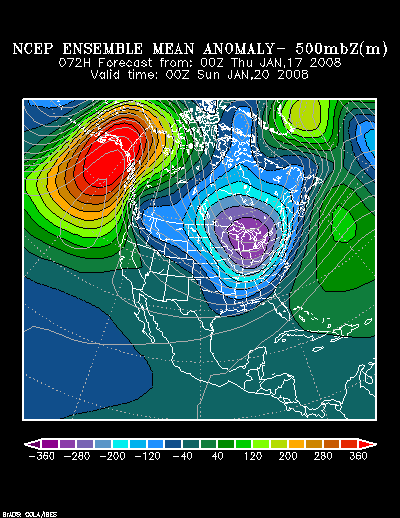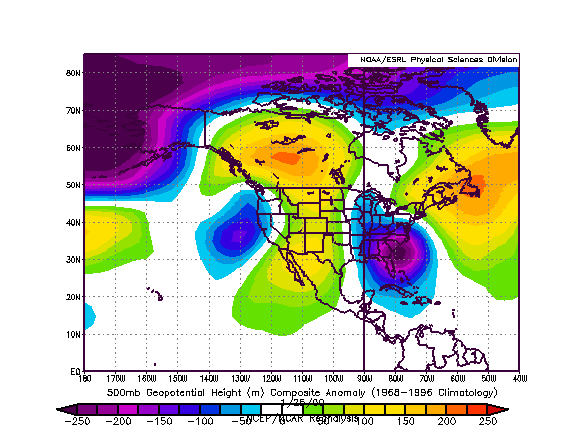#8 Postby donsutherland1 » Fri Jan 18, 2008 12:26 pm
Contrary to some enticing model runs yesterday, the guidance has returned to its earlier idea of a storm that will largely impact the Southeast and lower Mid-Atlantic region. Therefore, consistent with most such events that focus their heaviest snows on that part of the East, snowfall amounts will likely rapidly diminish once one moves northward in the Mid-Atlantic region.
Nevertheless, the storm could be special for a few areas that have not seen many significant snowfalls in recent years. Some of the below cities may have a shot at picking up 4” or more snowfall depending on the storm’s track and whether or not sufficient cold air is present during the height of the precipitation.
Most recent snowstorm with 4” or more snowfall:
Asheville: 4.4”, January 25-28, 2004
Atlanta: 4.6”, January 2-3, 2002
Birmingham: 13.0”, March 12-13, 1993
Charlotte: 12.0”, February 26-27, 2004
Norfolk: 5.0”, December 26, 2004
Raleigh: 6.5”, February 26-27, 2004
Richmond: 4.2”, December 5-6, 2005
Most recent snowstorm with 6” or more snowfall:
Asheville: 14.0”, January 27, 1998
Atlanta: 7.9”, March 24, 1983
Birmingham: 13.0”, March 12-13, 1993
Charlotte: 12.0”, February 26-27, 2004
Norfolk: 7.2”, January 3-4, 2002
Raleigh: 6.5”, February 26-27, 2004
Richmond: 7.7”, January 3, 2002
Given the latest guidance, synoptic pattern, and some weight given to historical climatology, my initial snowfall estimates are as follows:
Asheville: 2”-4”
Atlanta: 2”-4”
Birmingham: 1”-3”
Charlotte: 3”-6”
Columbia: 1” or less
Norfolk: 2”-4”
Raleigh: 3”-6”
Richmond: 1”-3”
The potential exists for greater accumulations at such locations as Atlanta, Charlotte, Norfolk, and Raleigh. The 6z and 12z runs of the NAM bring much larger accumulations to those cities.
Some recent Lower Mid-Atlantic Snowstorms:
February 26-27, 2004:
A snowfall for the record books trapped ambulances in icy drifts, stranded hundreds of travelers on highways and at airports, and will leave roads slick and scary this morning until higher temperatures melt it away in a slushy mess.
Parts of the region saw more snow fall in a 24-hour period Thursday and Friday morning than they have since 1902. South Charlotte had nearly a foot and a half of snow, while reports of 21 inches came from parts of Upstate South Carolina.
Another inch or so fell Friday afternoon across the region in giant fluffy flakes, delighting kids home from school and handing road crews -- already short on sleep and road salt -- another round of plowing…
Source: Scott Dodd and Peter Smolowitz, “Near-Record Snowfall Slows Travel, Closes Offices in Charlotte, N.C.,” The Charlotte Observer, February 28, 2004.
January 23, 2003: Outer Banks:
The arctic air that has had the East and Plains shivering for days spilled into the South on Thursday, bringing rare snowdrifts to North Carolina's Outer Banks and sending Florida citrus growers scrambling to save their freezing crops.
The first significant snowfall along the North Carolina coast in 13 years brought up to a foot of snow to the barrier islands.
Source: ”Cold brings snow, imperils citrus crop,” Chicago Tribune, January 24, 2003
January 3-4, 2002:
The snowstorm that brought much of the South to a standstill moved offshore, but cold air in its wake threatened to refreeze the slush and extend the misery.
Sunny skies began melting the remnants of the two-day storm that dumped up to 16 inches of snow in parts of Virginia, North Carolina, South Carolina and Georgia…
Source: “The Nation; In Brief/The South,” Los Angeles Times, January 5, 2002
January 24-25, 2000:
An unexpectedly fast-moving nor'easter charged up the East Coast Tuesday with more than a foot of wind-blown snow, closing airports and thousands of schools and making the morning commute dangerous.
Tens of thousands of people were without power.
Snow had already fallen 18 inches deep in North Carolina, and more than a foot was possible in New England by Tuesday night. Wind gusting to 30 m.p.h. made it feel well below zero from New Jersey to New England.
"People kept saying, `We haven't had winter,"' said Richard Jones, a forecaster with the National Weather Service in Raleigh, N.C. "I guess this will show them."
The snow even affected the presidential campaign. Most of the candidates flew to New Hampshire overnight after the Iowa caucuses, but Republican Alan Keyes was stuck in Detroit in late morning, trying to fly into Boston.
Thomas Allen looked out his front door this morning in Raleigh and knew immediately he wouldn't make it to work. "The snow has completely covered my car," he said. "It's gone. I can't even see it."
Snowfall totals of 14 inches were forecast for Virginia and the Washington suburbs, with 18 inches possible in eastern Pennsylvania.
Source: ”Blizzard Batters East Coast Cities With Snow, Cold,” Chicago Tribune, January 25, 2000.
0 likes


 The posts in this forum are NOT official forecast and should not be used as such. They are just the opinion of the poster and may or may not be backed by sound meteorological data. They are NOT endorsed by any professional institution or
The posts in this forum are NOT official forecast and should not be used as such. They are just the opinion of the poster and may or may not be backed by sound meteorological data. They are NOT endorsed by any professional institution or 








